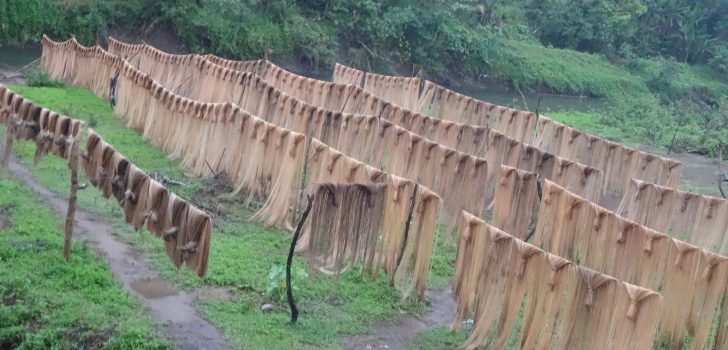 Known as the “abaca county,” Catanduanes is the country’s biggest abaca-producing province. However, PhilFIDA-Catanduanes projects the remaining supply of abaca to last only until April 2017 after typhoon Nina damaged 100 percent of abaca farm area in the province. (Photo by Annielyn L. Baleza, DA-PRDP RPCO V InfoACE Unit)
Known as the “abaca county,” Catanduanes is the country’s biggest abaca-producing province. However, PhilFIDA-Catanduanes projects the remaining supply of abaca to last only until April 2017 after typhoon Nina damaged 100 percent of abaca farm area in the province. (Photo by Annielyn L. Baleza, DA-PRDP RPCO V InfoACE Unit) DA-PRDP addresses looming abaca supply shortage by supporting abaca rehabilitation in Catanduanes
Jona Camacho, 42, treaded the muddy trail leading to her makeshift house where her three children happily greeted her, kissed her hands then scrambled over the green mangoes which she bought for snacks. Camacho knew it will not suffice, but for now, that is all she can afford from what was left in her wallet after attending the Business Planning Workshop and Coaching, organized by the Philippine Rural Development Project (PRDP) in Virac, Catanduanes.
Camacho, president of the Sustainable Livelihood Program Association (SLPA) in Brgy. Kilikilihan, San Miguel, Catanduanes, was one of the abaca farmer-leaders invited to attend the said activity to help abaca and mangrove crab farmers like her who were heavily devastated by typhoon Nina on December 25, 2016. Like the other participants in the business planning workshop, Camacho was hopeful that PRDP would save them from looming poverty once the abaca supply in the province are depleted.
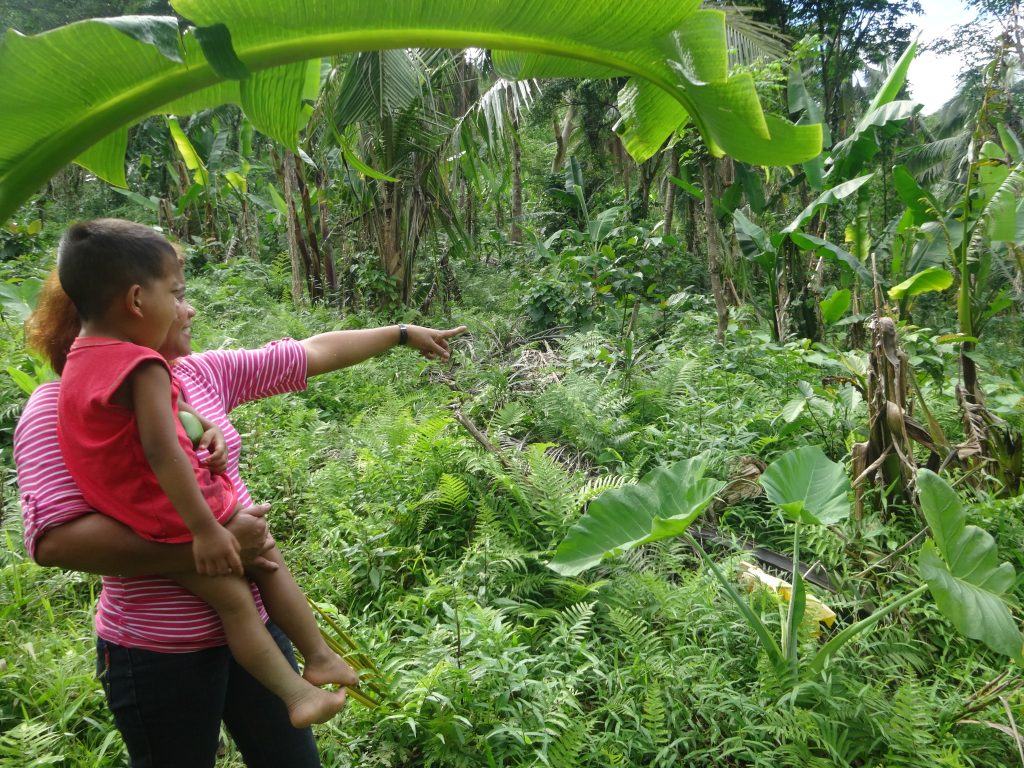
Sustainable Livelihood Program Association (SLPA) President Jona Camacho points the abaca plantation devastated by typhoon Nina last December 25, 2016. It would take 18 to 24 months before they recover, hence the need for the rehabilitation. (Photo by Annielyn L. Baleza, DA-PRDP RPCO V InfoACE Unit)
“Kapag naputol na po ang mga abaca, matagal pa bago ’yon tumubo ulit. Ngayon, meron pa kasi inuuna nga ’yong mga putol kaya nakakakuha pa kami pero ’pag nawala na ’yon… Sa next year ngani hindi namin alam kung saan kami kukuha ng kabuhayan kasi ’yon lang ang pinagkukuhanan namin ng hanapbuhay (It takes time to revive damaged abaca trees. Now, we still harvest the truncated abaca trees, but we will have no more left once we have exhausted them. We are uncertain about our source of income next year because it’s our only means of livelihood here),” she said.
PRDP offered to provide fund amounting to about P55 million originally committed by the Department of Agriculture (DA) Secretary Emmanuel Piñol for the rehabilitation of abaca in Catanduanes. Known as the “abaca county,” Catanduanes is the country’s biggest abaca-producing province with 11 municipalities and 212 barangays engaged in abaca production. The province contributes around 92.3 percent of Bicol’s abaca production, with the highest reported productivity of 600 kilograms per hectare. PRDP’s Abaca Value Chain Analysis (VCA) shows that as of December 2013, about 12,734 farmers cultivate an abaca production area of 33,051.25 hectares.
Based on the Philippine Fiber Industry Development Authority’s (PhilFIDA) Crop Damage Report as of December 28, 2016, however, typhoon Nina’s wrath damaged 100 percent or 23,195.42 hectares of abaca farm area in Catanduanes. Among the hardly hit areas are the municipalities of San Miguel, Virac, Bato, Baras and San Andres. In Camacho’s home town, 3,895.92 hectares or 90 percent of abaca farm areas were devastated by the typhoon. Cherryl Tatel, Officer in Charge of the Municipal Agriculturist Office of San Miguel, said that the total cost of abaca damage was calculated at P136,357,200.
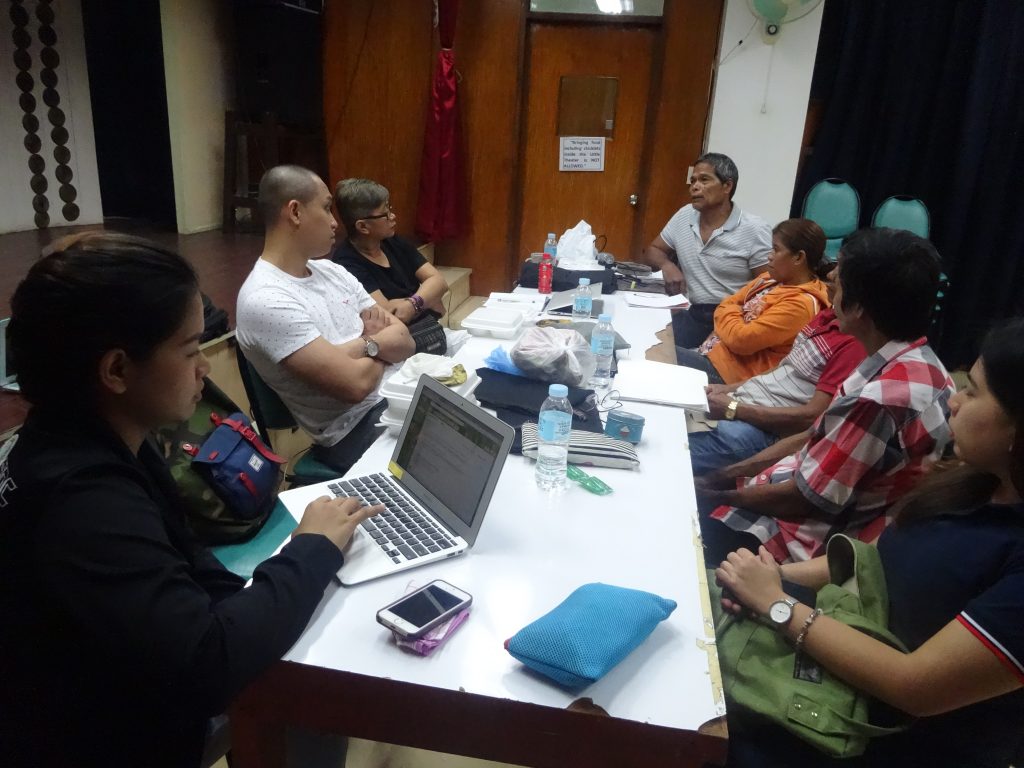
PRDP-Bicol I-REAP Business Development Officer Victoria Eugene Florece (3rd from left), PRDP South Luzon I-REAP Component Head Manolo Luis Herrera (center, left), Environmental Safeguards Specialist Maria Iris Millendez (1st from left), and Economist Kathryn Louise Parungao (1st from right) discuss the potentials of integrated abaca farming to proponent groups who attended the Business Planning Workshop and Coaching held in Virac, Catanduanes on February 21–23, 2017. (Photo by Annielyn L. Baleza, DA-PRDP RPCO V InfoACE Unit)
“In four to six months, wala nang abaca (there will be no abaca) and it would take two to three years bago ma-replenish,” Tatel said.
This was supported by PhilFIDA-Catanduanes Provincial Fiber Officer Lorgen Garcia, who admitted that the remaining supply of abaca is projected to last until April 2017. She said that immediate rehabilitation is necessary or else abaca farmers, particularly in the landlocked municipality of San Miguel, will lose their only source of income.
PRDP has an approved I-REAP subproject under procurement in Virac, Catanduanes in support of its commodity value chain for abaca. Complementary to the Project’s development objectives, the P19.45 million-worth Abaca Fiber Processing and Trading Enterprise in Virac, Catanduanes to be implemented by the Pinoy Lingap Damayan Multi-Purpose Cooperative (PLDC) targets to raise the annual income of its 3,483 abaca farmer-members from P4,260 a month per farmer on the first year of operation to P5,142.32 per month on the tenth year. Currently, PLDC has a target volume of 30 to 40 tons per week to support its business. Yet, with the state of the abaca plantations in the province, implementing the said I-REAP subproject is quite a challenge.
“We have an approved I-REAP subproject. In a few months, mawawala na ang supply, we really have to do something about the supply (We have an approved I-REAP sub-project. In a few months, supply will be depleted, we really have to do something about it),” PRDP South Luzon Project Support Office (PSO) Director Shandy Hubilla said.
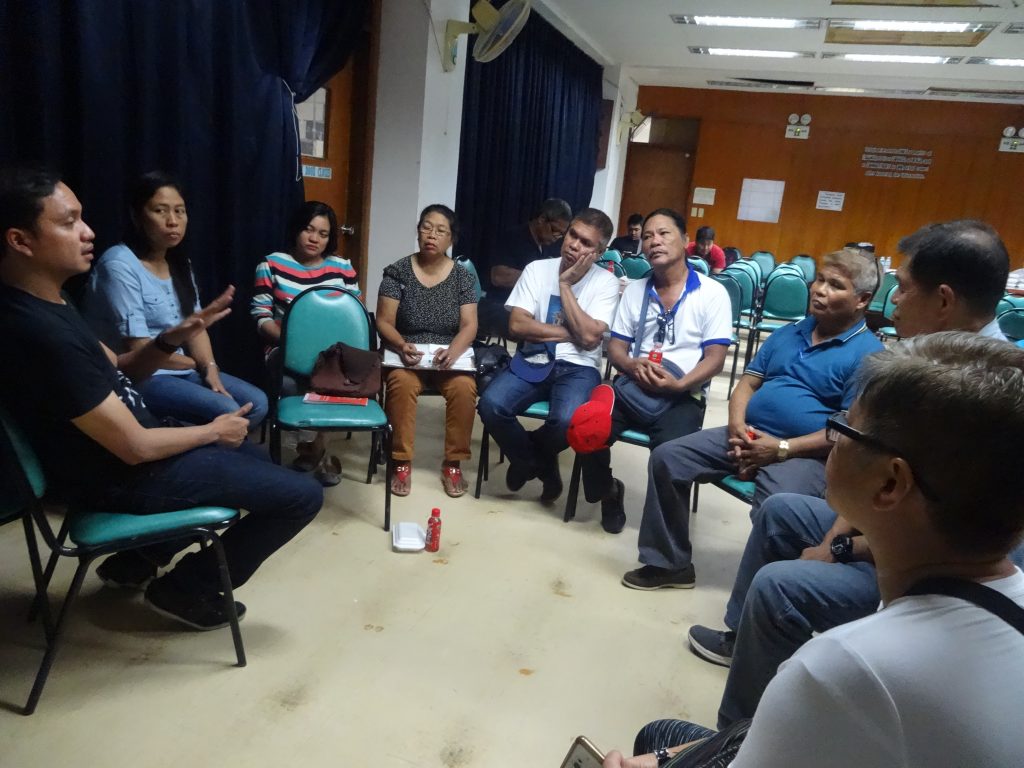
PRDP South Luzon Director Shandy Hubilla (1st from left) solicits the support of the municipal agriculturists and proponent groups in the Project’s effort to rehabilitate the abaca plantations in the province to sustain the supply of abaca for the Abaca Fiber Processing and Trading Enterprise in Virac, Catanduanes, the Project’s approved I-REAP subproject in the province. (Photo by Annielyn L. Baleza, DA-PRDP RPCO V InfoACE Unit)
On February 21–23, 2017, the PRDP South Luzon I-REAP component headed by Manolo Luis Herrera, along with Bicol I-REAP Business Development Officer Victoria Eugene Florece and their staff, oriented the participants about the I-REAP process. They also conducted proponent group profiling to determine prospective partners in integrated abaca farming to commence the rehabilitation of abaca plantations in the province. Herrera said that it takes 18 months up to two years for abaca to recover, thus, I-REAP has to integrate income-generating projects like livestock or cash crop production for the abaca farmers on the first year, while replanting and rehabilitating the abaca plantations.
The PRDP I-REAP team will assist the qualified proponent groups in preparing business plans for microenterprise subprojects that are worth less than P3 million each. Sixty percent of the total enterprise project cost (TEPC) will come from the World Bank, while the 20 percent will come from the DA, and another 20 percent will come from the provincial local government unit’s development fund. The proponent groups shall also share a counterpart worth 20 percent of the TEPC.
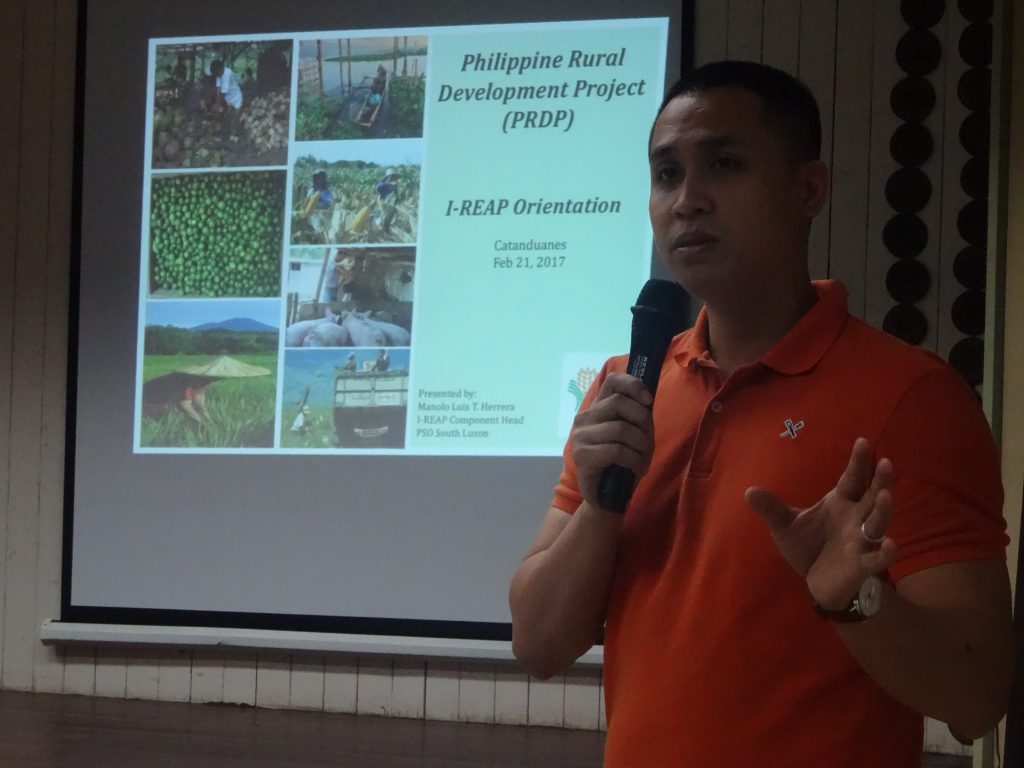
PRDP South Luzon I-REAP component head Manolo Luis Herrera orients the municipal agriculturists and proponent groups from the areas hardly hit by typhoon Nina in Catanduanes about the enterprise development (I-REAP) component of the Project and its objective to assist abaca farmers in the rehabilitation of the abaca plantations in the province. (Photo by Annielyn L. Baleza, DA-PRDP RPCO V InfoACE Unit)
Camacho hopes that her cooperative will be one of the qualified proponent groups to benefit from PRDP’s abaca rehabilitation project. After the typhoon, her husband, an abaca farmer, could still harvest 10 kilograms of abaca per day which they sell for P65 per kilogram. She estimated that their stocked abaca fiber would only last until December of this year.
“By next year, talagang tios na digdi samuya kasi kung ’di man nagbagyo ’di man kami matios, sana lang, siguro ’yong iba man na pagkakitaan p’wede man pero ’di ’yon masapat sa ayog samuya na kadakol (By next year, we might experience extreme poverty. If only we’re not hit by the typhoon, we won’t suffer. Other livelihood activities may work but they won’t be enough to support a big family like ours),” she said.
Camacho budgets her husband’s income to their household needs and their six children’s allowances. Her eldest is a grade 11 student taking up Beauty Care in Manila. She also has twin daughters who are in grade 8, and two sons who are in grade 5 and kindergarten, respectively. Her youngest son is only three years old.
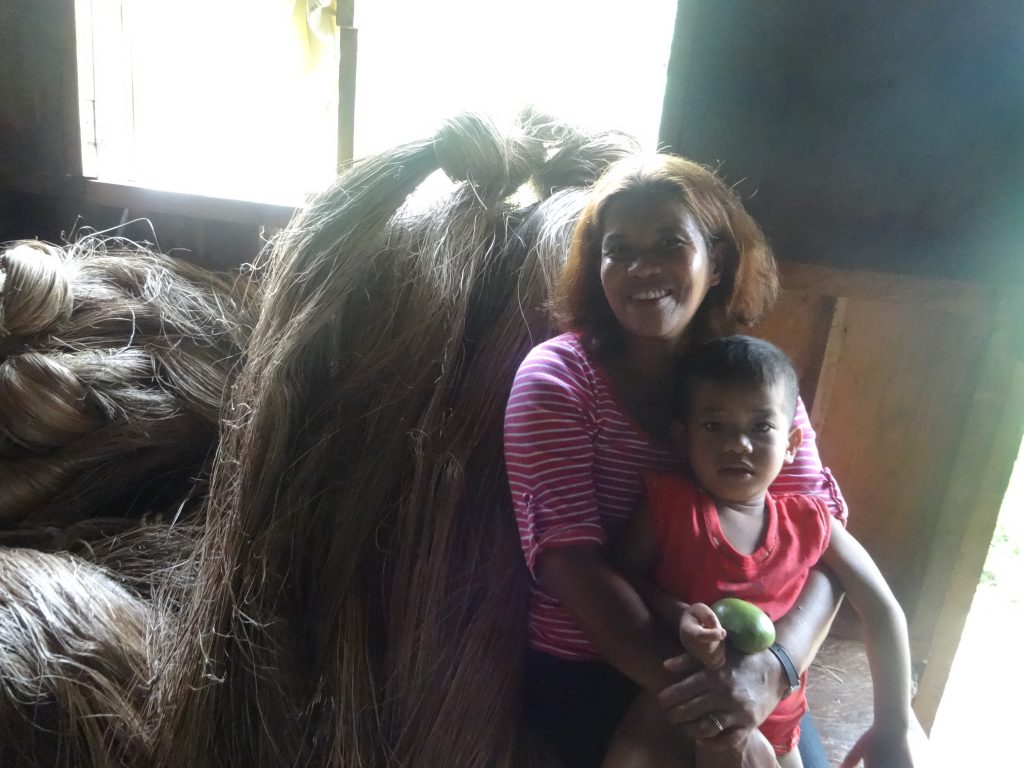
Jona Camacho, 42, president of the Sustainable Livelihood Program Association (SLPA) in Brgy. Kilikilihan, San Miguel, Catanduanes (seen in this photo with her three-year-old son Gerald) is one of the prospective abaca farmer-leaders to benefit from the abaca rehabilitation to be funded under the Philippine Rural Development Project’s (PRDP) enterprise development (I-REAP) component. (Photo by Annielyn L. Baleza, DA-PRDP RPCO V InfoACE Unit)
Tatel said that the PRDP-led abaca rehabilitation will be very beneficial to the abaca farmers not only in San Miguel but in the whole province.
“Makakatulong ang project na ito kasi after four to six months na mag-harvest sila ng mga na-recover na fiber, (sana) na ma-rehab naman kasi ’yong time na mahal ’yong abaca, parang wala na silang time na magtanim, mag-rehab, harvest lang ng harvest. Ang program na ito ay makakatulong upang magkaroon sila ng income at the same time ’yong kanilang lupa mapupunuan ng bago (This project will be very beneficial to the abaca farmers. After four to six months of harvesting the recovered abaca, it is time to rehabilitate the abaca plantations, because they did not have time to replant after the typhoon),” she added.
The PRDP I-REAP team targets to have the microenterprise subproject proposals approved by the Regional Project Advisory Board by April 2017 for the immediate issuance of the No Objection Letter 1 or the approval to start the procurement process. The effort to rehabilitate the abaca plantations in Catanduanes was in support of President Rodrigo Duterte and Secretary Piñol’s pledge to allocate P55 million to help farmers recoup their production losses when they flew in to Catanduanes three days after typhoon Nina.
PRDP is a six year development project being implemented by the DA to establish an inclusive, value chain-oriented and climate-resilient agri-fishery sector. Following the “down to top” approach in enterprise plan preparation and implementation, the Project targets at least five percent increase in household incomes of farmers and fisherfolk beneficiaries, seven percent increase in value of annual marketed outputs, 30 percent raise in incomes for targeted beneficiaries involved in enterprise development and 20 percent increase in number of farmers and fisherfolk with improved access to DA services. ### (Annielyn L. Baleza, DA-PRDP RPCO V InfoACE Unit)
